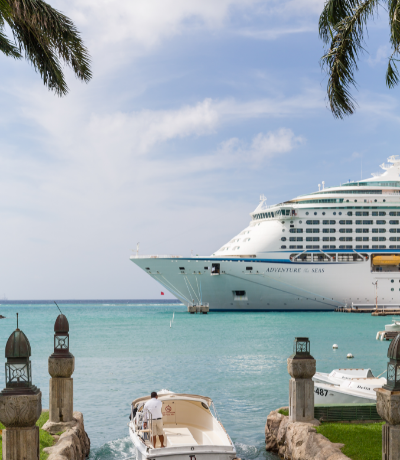How do you pack for a safe cruise?
15 February 2025
Packing for a cruise involves more than just swimsuits, flip flops, and sunscreen. Smart travelers know the importance of being prepared for their ocean adventure. From health essentials to weather-appropriate gear, your packing choices can enhance your safety and peace of mind at sea.
Before you start filling your suitcase, it’s important to understand that cruise ships have strict regulations about what can and cannot be brought aboard. These rules aren’t meant to inconvenience passengers—they’re designed to protect everyone’s safety, maintain crucial ship operations, and preserve marine environments.
While the ship will provide life jackets and other critical safety equipment, you can bring several personal safety items, and importantly, some you must leave at home.
In this guide, we’ll explore the essential safety items you should consider packing, explain why certain items are prohibited for safety reasons, and help you make informed decisions about your cruise preparations.

Don’t pack these
Let’s start with what you can’t take on board. Many of the items in this list are things you may typically pack; however, they are specifically banned from cruises because of the risk to passenger and ship safety:
- Baby monitors (can interfere with the ship’s navigation systems)
- Walkie-talkies and amateur radios (can disrupt the ship’s radio communications)
- Satellite phones (some cruise lines restrict these)
- Drones (can interfere with ship’s systems and pose physical hazards)
- Helium balloons (potential marine life hazard if lost overboard)
- Pool inflatables (evacuation hazard)
- Clothes irons and steamers (fire hazard risk)
- Surge protectors (also a fire hazard)
Essential Safety Items for Your Cruise
When preparing for your cruise vacation, consider packing these safety-focused items to protect yourself and your loved ones:
Medical and Health Safety
- Basic first-aid kit with bandages, antiseptic wipes, and over-the-counter medications
- Prescription medications in original containers, plus copies of prescriptions
- Motion sickness remedies (patches, wristbands, or medications)
- Small bottle of hand sanitizer and disinfecting wipes
- Medical alert bracelet or card (if applicable)
Child Safety Items
- Child-proof door locks for cabin doors and balconies
- Nightlight for unfamiliar cabin environment
- ID wristbands with parent contact information
- Children’s life jacket (though ships provide these, some parents prefer their own)
- A baby monitor that doesn’t use radio frequencies (check with the cruise line for approved models)
Senior Safety Considerations
- Non-slip shoes for wet decks
- Portable grab bar for bathroom safety
- Small flashlight or battery-operated night light for navigating dark cabins
- Mobility device batteries and backup parts (if needed)
- Emergency contact card with medical conditions and medication list
Weather and Environmental Protection
- Reef-safe sunscreen and after-sun care
- Wide-brimmed hats and UV-protective clothing
- Insect repellent for port visits
- Small battery-operated fan (UL certified)
- Light rain jackets or ponchos for excursions
Tech Safety Items for Your Cruise
Keeping your devices safe and charged requires some planning, as cruise ships have different electrical systems than on land. Here’s what you need to know:
Charging Safety
- Bring cruise-approved power strips without surge protection
- Use dual-voltage chargers (110V/220V)
- Pack shorter charging cables to manage limited outlet space
- Consider a battery pack for shore excursions (check airline restrictions if flying)
Protecting Your Devices
- Waterproof cases or pouches for phones and cameras
- Dry bags for electronics during beach excursions
- Anti-theft laptop locks for cabin use
- Humidity-resistant camera bags
- Screen protectors for salt air exposure
Essential Port Safety
When exploring ports of call, keep these safety measures in mind:
Prepare your cabin
- Store valuables in your cabin safe
- Lock the balcony doors and close the blinds
What to take with you
- Photocopy of passport (keep original in ship’s safe)
- Limited cash and one credit card
- Ship’s port schedule with all-aboard times
- Ship’s emergency contact number
- Local emergency numbers
- Bottle of water and snacks
What to leave behind:
- Expensive jewelry
- Unnecessary and heavy electronics
When you take an excursion off the cruise ship, it’s your responsibility to return to the boat before departure time. Most cruise travelers stick to booking excursions with the cruise line for guaranteed return times.
See what happened to eight passengers who took a private tour and missed the all-aboard time.
Getting Medical Help on a Cruise
Most cruise ships have some medical staff on board: 1-2 doctors and 2-6 nurses on larger ships. There are also basic medical facilities, such as an infirmary—not a full hospital—and basic diagnostic equipment to treat common medical issues like:
- Motion sickness
- Minor injuries
- Basic illnesses
- Some common prescription medicines
- Over-the-counter medicines
The medical staff can also provide emergency stabilization for serious conditions. A passenger with a serious health condition will be airlifted to the closest hospital – at their expense, not the cruise ship’s.
Important considerations
- Costs are typically out-of-pocket and charged to your cabin account
- Most regular health insurance is not accepted onboard
- For serious conditions, patients will be evacuated to land facilities
- Travel insurance is strongly recommended to cover potential medical expenses
See how one cruise passenger got a $47,000 medical bill on a cruise!
Safety Tips
- Pack any regular medications you need and consider travel insurance that covers medical evacuation. Treatment costs on cruise ships can be expensive, and evacuation costs can be extremely high.
Planning ahead for safety doesn’t mean expecting problems—it means being prepared to fully enjoy your cruise with peace of mind. Having your own carefully chosen safety items can make a significant difference in handling minor issues and being comfortable.
Remember to check your cruise line’s specific regulations before packing, consider purchasing comprehensive travel insurance, and keep all important documents and medications easily accessible.
Related topics
Damian Tysdal is the founder of CoverTrip, and is a licensed agent for travel insurance (MA 1883287). He believes travel insurance should be easier to understand, and started the first travel insurance blog in 2006.
